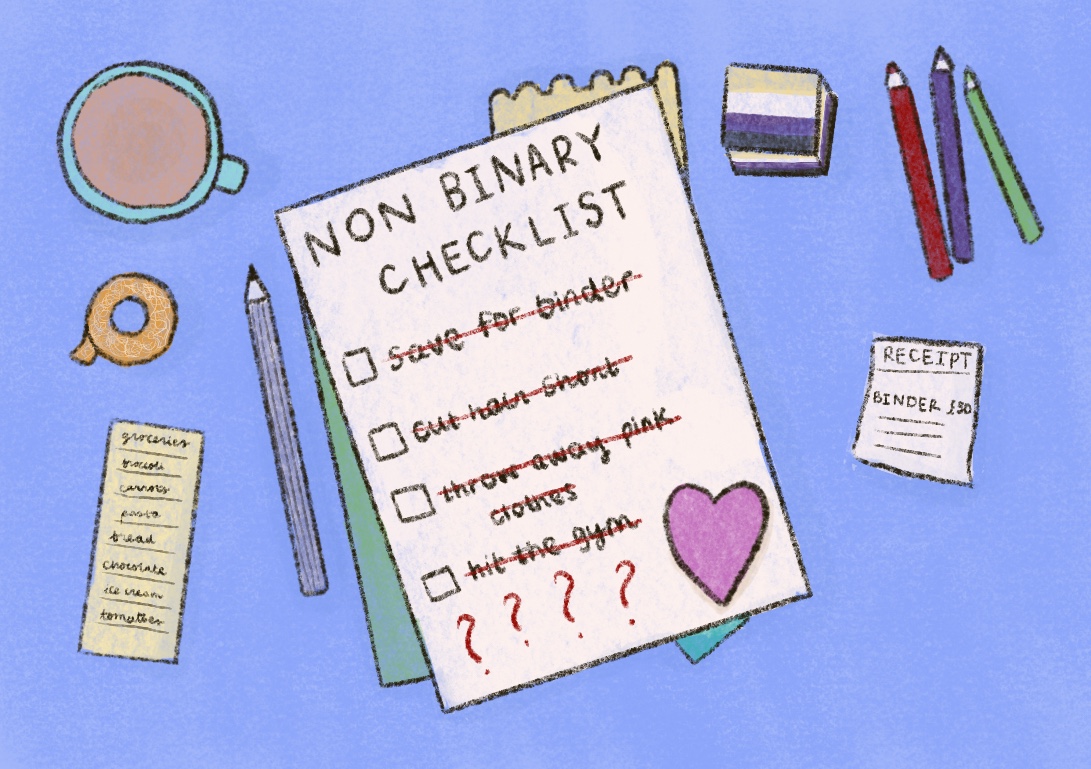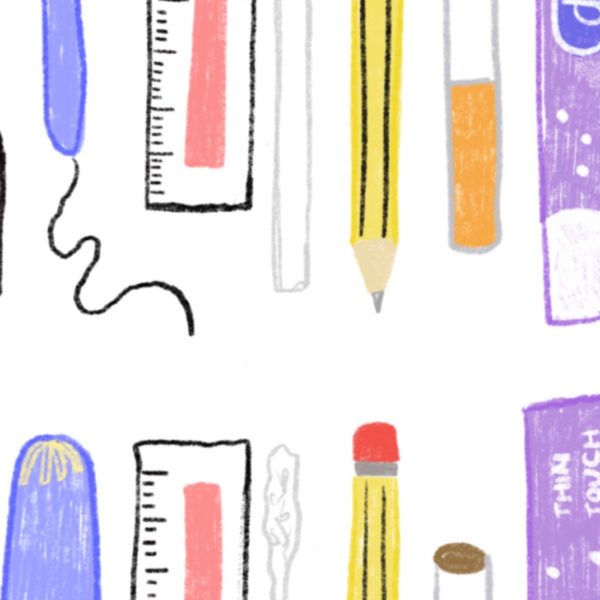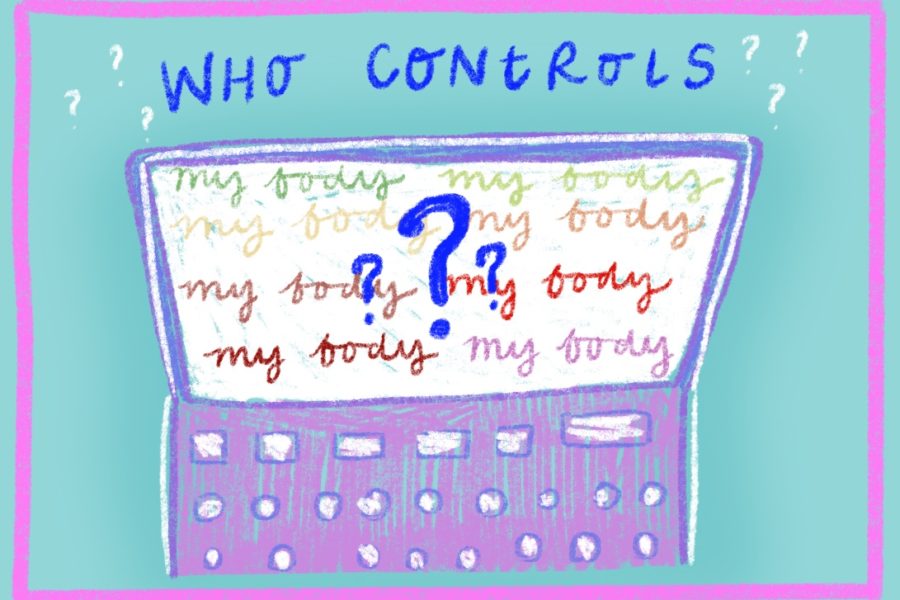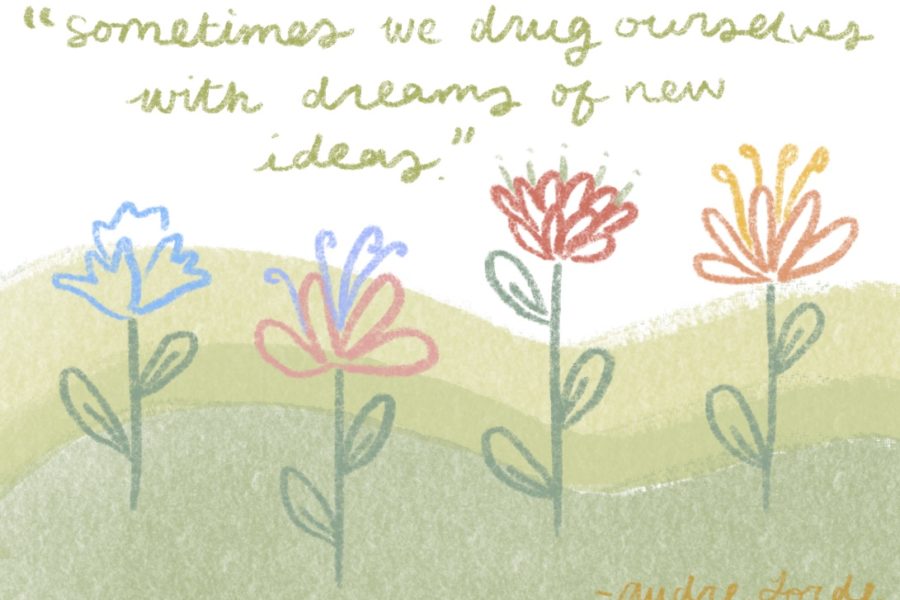first thought that came into my head when I realised I was non-binary was fuck, I don’t want to chop all my hair off. This was swiftly followed by a succession of minor panics: I don’t have the face for short hair, I don’t have the shoulders for androgyny, and everyone knows that my arse is simply too big to pass as anything but a woman. These thoughts accompanied thousands more over the next few months as I embarked on an excruciating – but ultimately liberating – internal journey.

Non-Binary People Don’t Owe You Androgyny, Fuck Off
CW: eating disorders, disordered eating behaviours, body image, gender dysphoria
I’m sure by now that most people will have at least heard of the gender identities that are ‘non-binary’, and have a vague notion of what that means. As non-binary identities have become more accepted, it appears that humans have done what humans do best: constructed non-binariness as its own, new category that sits comfortably between the widely understood notions of femininity and masculinity. I see this particularly in non-binary representation in the media: there is a specific archetype which has emerged, which typically looks like a middling-height, pale-skinned, thin individual with short hair and chiselled facial features. Androgyny at its finest. This archetype, and its presence in the media specifically, was the only representation I had of how to be in my new gender identity, and a way to be accepted in that identity by wider society. I had no idea that it was just another beauty standard (for me a completely unachievable one), like all the others that are created by the structures of white supremacy, diet culture, and the patriarchy. I believe it’s a standard created to make non-normative gender identities more palatable to the public. Of course, presenting in that way is completely valid and wonderful, like all expressions of gender, and I am not at all trying to undermine it; I merely want to highlight how these stereotypes have been taken and used by the cishet world, and how they are not representative of the genderqueer community as a whole.
Little old me, not knowing what else to do, latched onto this image, and it did a lot of damage. I grappled with my gender identity even more intensely after figuring out what it was, because I didn’t fit it. I felt I didn’t look non-binary enough, and the things I believed I had to do in order to ‘complete’ myself were either dangerous, expensive, or didn’t feel like me.
One of the first times I ever remember feeling gender dysphoria was in a Year 5 PE lesson (aged around ten), after I had started growing boobs. I remember looking at all the girls in my class, with their flat chests and spindly arms, and wondering why on earth I didn’t look like that. It wasn’t long until I started feeling it more often: my little sister laughing and asking why my bum was sticking out; my thighs thickening and trousers tightening around them; dresses sitting on me differently. I developed an acute, agonising awareness of my own body, and inside it all of me was tightening, tensing, and twisting in an attempt to understand why my fleshy vessel was so uncomfortable, so lumpy. I felt swollen, like how your fingers feel as you warm them up after being out in the cold. My whole body was just wrong.
When I started at an all-girls secondary school and everyone was comparing their tummy fat, pinching bits of themselves (bits that I had more of than them), and discussing the numbers they saw on the scales, a new experience for me began: body dysmorphia. I spent the next ten years desperately trying to combat both these conflicting experiences, not knowing why I felt them, not having even a limited understanding of what it was that was happening to me. I lived for ten years with multiple eating disorders, determined to shrink myself down to the ideal self-image I had in my head, but no matter what I did, or how I looked, I was never able to achieve it. You can imagine my dismay when I finally recognised myself as non-binary, but believed that that meant I had to be small, with a straight up-and-down figure, and entirely different features to my own. What I had always believed to be body dysmorphia now had been identified as both that and gender dysphoria, and despite providing me with two separate types of self-loathing, both were intrinsically linked in that they had the same final goal, with the same solution: to alter myself until I fit the picture I’d always had in my mind of how I should look. But now the image I’d had in my head had been externalised. The ideal I’d given myself had been confirmed by society, and now more than ever I had to achieve it.
In fact, this experience is not uncommon. Trans and non-binary people experience alarmingly high rates of body image issues, disordered eating, and eating disorders. A study of 300,000 US students found that 15% of those who identified as transgender had been diagnosed with either anorexia or bulimia nervosa, or had engaged in ‘compensatory behaviours’ in the month before the study. Compensatory behaviours are behaviours with the aim of ‘making up for’ or purging food consumed, in order to maintain or achieve lower body weight. This is in contrast to an average of 3-5% amongst cisgender populations. Unfortunately, this is unsurprising to me: trans people can feel extreme pressure to adhere to the beauty standards determined by the gender binary, thinness being a major one.
Extreme weight loss can also reduce gender dysphoria by causing reductions in breast size, fat loss and redistribution, changes in face shape, and loss of periods. I for one still have a very complicated relationship with my period, having delayed getting my first ever one by several years due to my eating disorder when I was younger. I spent most of my late teens dreading that time each month when I’d be overwhelmed by feelings of dysphoria, and the shame that I associated with having ‘failed’ to keep my period away for yet another month. Binge-eating, another form of disordered eating, can help numb and overwhelm feelings of discomfort and dysphoria that are often experienced by trans people. There remains very limited research on the prevalence of eating issues amongst trans people in comparison to the cis population, but it is certainly an area of importance, especially within conversations regarding trans healthcare and improvements that are needed.
The need to present as the ideal form of your gender identity in order to be accepted, or to pass, or to be a slightly more acceptable version of the minority group that we are, is a story that I’ve heard over and over again from people in the trans community. To live as the picture of femininity, masculinity, or androgyny; to match up to the widely seen representatives of the community that we see being accepted, even celebrated, by wider society. I know I’ve felt it. I know I’ve wanted to reduce any chance I may have of being cast as too different, too big, too trans. The constant comparison with the cis ideals, the trans ideals, our own imagined ideals – it just makes dysphoria worse, and presents more challenges than it helps solve.
At the time, I had no idea that gender dysphoria was what I was feeling. I actually thought I was making myself more feminine, more desirable under that ever-watchful male gaze. But hindsight has been a blessing for me; and since a gruelling, arduous, and challenging recovery process during the Covid-19 pandemic, I have had the chance to reflect on much of my experience over the last decade. I have not only recognised my own, true gender identity, but been able to piece all the bits together and work towards a much different relationship with my body. Looking back, I am able to distinguish the feelings of gender dysphoria I have experienced throughout my life, and acknowledge the ways I tried to alleviate them. And most importantly, I no longer have an image in my mind of how I should look, of what my gender presentation should be. I’m learning about my non-binary self, my non-binary body, my recovered self, and my recovered body, and I’m working on living with all of them in tandem with each other. I’m approaching body issues with caution and empathy, speaking to myself more gently, and trying my best not to berate myself for simply existing as I am.
And it’s led to some true moments of gender euphoria. Like last week, when a friend described my new hairstyle as ‘genderless’ – a hairstyle I’d spent a very long time being too afraid to get. Or last month, when I decided to fully embrace the femininity I’d been too scared to show for fear of being ‘fake’ or perceived as just pretending to be non-binary. Since then I’ve been painting my nails pink and wearing clothes that accentuate my curves, rather than trying to hide them. Because that’s what makes me feel good. None of this takes away from my gender identity – in fact, it completes it. Each person’s gender identity is entirely their own, and the way they express it, the things that make them feel good, is completely unique. And that may sound very obvious, but it took me years and years to finally realise it.
I’ve learned so much about non-binariness recently.
I’ve learned that to be non-binary is to reject the gender binary, not necessarily to find a new place in it. The binary as we know it was created by the white supremacist patriarchy, and for me and many others, it is restrictive, suffocating. I point out here that I see no issues in an individual identifying with the binary – I just wholeheartedly advocate for each person having the chance to explore where they sit with their own gender identity, and choosing their position for themselves, rather than have a binary imposed on them by external structures. Atalanta Sawdon Harkavy likens being non-binary to being an atheist – you are defined by your lack of specific religion, your lack of specific gender. Nobody expects you to decide if you are part Muslim, part Hindu, so why should we follow that pattern with gender?
I’ve learned that to be non-binary is to be liberated from all norms, expectations, and restrictions created by the gender binary; it means to embrace all forms of femininity, masculinity, androgyny, gender, and lack thereof. It is to be all genders and no genders and maybe just a little glittery sprinkle of gender every now and then. Each non-binary person is non-binary in their own way, and every gender identity is different: there is no one way to look, be, or identify.
I’ve learned that at the very root of non-binariness is fundamental acceptance and unconditional permission to be yourself, no matter what that looks like or how different that makes you. For some, indeed, the more different the better! I still struggle with this, but what’s different for me now, rather than how I felt a year ago, is that I know that however I feel inside my body, or however I express my gender, there is no wrong way of doing it. I still feel dysphoria and dysmorphia, I still sometimes feel horrible and anxious and depressed about the way I look, the way I’m perceived, the risk of being misgendered. I spend a lot of time fearful that I may be too non-binary, or not non-binary enough. But I am not going to solve these issues with a socially prescribed solution – I’m going to solve them by working alongside myself, doing what’s best for me, not as my own enemy. No more blame for being the way I am, because the way I am, my own, unique non-binariness, is fucking great.
I’ll leave you with this quote, again from Atalanta Sawdon Harkavy, which really struck a chord with me. Personally I love the use of the word queerness, because to me it just sums up my identity, and how much I want to say a massive fuck you to all the people, structures, and social norms that have ever made me feel like I am the problem.
“If being male has masculinity, and being female has femininity, being non-binary has queerness.”
References and further reading:
Eli Cugini, 2021 – “When Thin Is a Trans Requirement”, Autostraddle.
Atalanta Sawdon Harkavy, 2021 – “Not a Third Gender”, Varsity.
Elizabeth W. Diemer et al., 2015 – “Gender Identity, Sexual Orientation, and Eating-Related Pathology in a National Sample of College Students”, Journal of Adolescent Health, 57.
Abigail Thorn, 2021 – “Food, Beauty, Mind | PhilosophyTube”, YouTube.
If you are struggling with any of the issues discussed, here are some places you can seek support:
- Scottish Trans – Useful organisations
- Together We Can – Resources for trans and non-binary people
- Beat Eating Disorders
- Mind
- Samaritans
Meg Reynolds, Environmental Editor
Header Image by Lucia Villegas, one of Clitbait’s wonderful Graphic Designers




Leave a Comment